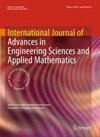Antioxidant activity and inhibition of α-glucosidase from extract and fraction of leaves and stems of Vernonia amygdalina
IF 0.8
Q3 ENGINEERING, MULTIDISCIPLINARY
International Journal of Advances in Engineering Sciences and Applied Mathematics
Pub Date : 2023-09-01
DOI:10.11591/ijaas.v12.i3.pp274-284
引用次数: 0
Abstract
Previous studies have shown that bitter leaf (Vernonia amygdalina Del.) has the ability as an antioxidant and an α-glucosidase inhibitor. Still, the difference in antioxidant activity and α-glucosidase inhibition based on the leaves and stems parts have not yet been determined. The effect of flavonoid-enriched extract on antioxidant activity and inhibition of α-glucosidase has not yet been determined. This research aimed to assess the impact of flavonoid-enriched extract from the leaves and stems part of the bitter leaf. The leaves and stems part of the bitter leaf were extracted using Soxhlet apparatus with 80% methanol and then underwent successive fractionation with petroleum ether, chloroform, and ethyl acetate. The crude extract and the fraction were concentrated and followed by the determination of total flavonoid, total phenolic, antioxidant activity, α-glucosidase inhibition activity, and calculated the IC50 of α-glucosidase inhibition. This research showed that chloroform-ethyl acetate leaf fraction was the best fraction with the higher total flavonoid (24.091±0.972 mg QE/g DW), total phenolic (84.299±4.589 mg GAE/g DW), diphenylpicrylhydrazyl (DPPH) antioxidant activity (33.881 μM TE/g DW), ferric reducing antioxidant power (FRAP) antioxidant activity (312.022±1.745 μM TE/g DW) and α-glucosidase inhibition activity with an IC50 value 1.23 mg/mL.苦扁桃叶、茎提取物及部位抗氧化活性及α-葡萄糖苷酶抑制作用
先前的研究表明苦叶(<em>Vernonia amygdalina</em>Del.)具有抗氧化剂和α-葡萄糖苷酶抑制剂的作用。尽管如此,叶片和茎部在抗氧化活性和α-葡萄糖苷酶抑制方面的差异尚未确定。富黄酮提取物对抗氧化活性和α-葡萄糖苷酶的抑制作用尚未确定。本研究旨在评估从苦叶的叶和茎部分提取的富含黄酮类化合物的提取物的影响。以80%甲醇为溶剂,用索氏仪提取苦叶的叶和茎部分,然后用石油醚、氯仿、乙酸乙酯进行连续分馏。将粗提物和提取物进行浓缩,测定其总黄酮、总酚、抗氧化活性、α-葡萄糖苷酶抑制活性,并计算IC<sub>50</sub>α-葡萄糖苷酶抑制作用。研究表明,氯仿-乙酸乙酯叶段为最佳部位,总黄酮含量(24.091±0.972 mg QE/g DW)、总酚含量(84.299±4.589 mg GAE/g DW)、二苯基苦酰水合基(DPPH)抗氧化活性(33.881 μ TE/g DW)、铁还原抗氧化能力(312.022±1.745 μ TE/g DW)和α-葡萄糖苷酶抑制活性(IC< 50</sub>值1.23 mg/mL。
本文章由计算机程序翻译,如有差异,请以英文原文为准。
求助全文
约1分钟内获得全文
求助全文
来源期刊

International Journal of Advances in Engineering Sciences and Applied Mathematics
ENGINEERING, MULTIDISCIPLINARY-
自引率
0.00%
发文量
6
期刊介绍:
International Journal of Advances in Engineering Sciences and Applied Mathematics will be a thematic journal, where each issue will be dedicated to a specific area of engineering and applied mathematics. The journal will accept original articles and will also publish review article that summarize the state of the art and provide a perspective on areas of current research interest.Articles that contain purely theoretical results are discouraged.
 求助内容:
求助内容: 应助结果提醒方式:
应助结果提醒方式:


